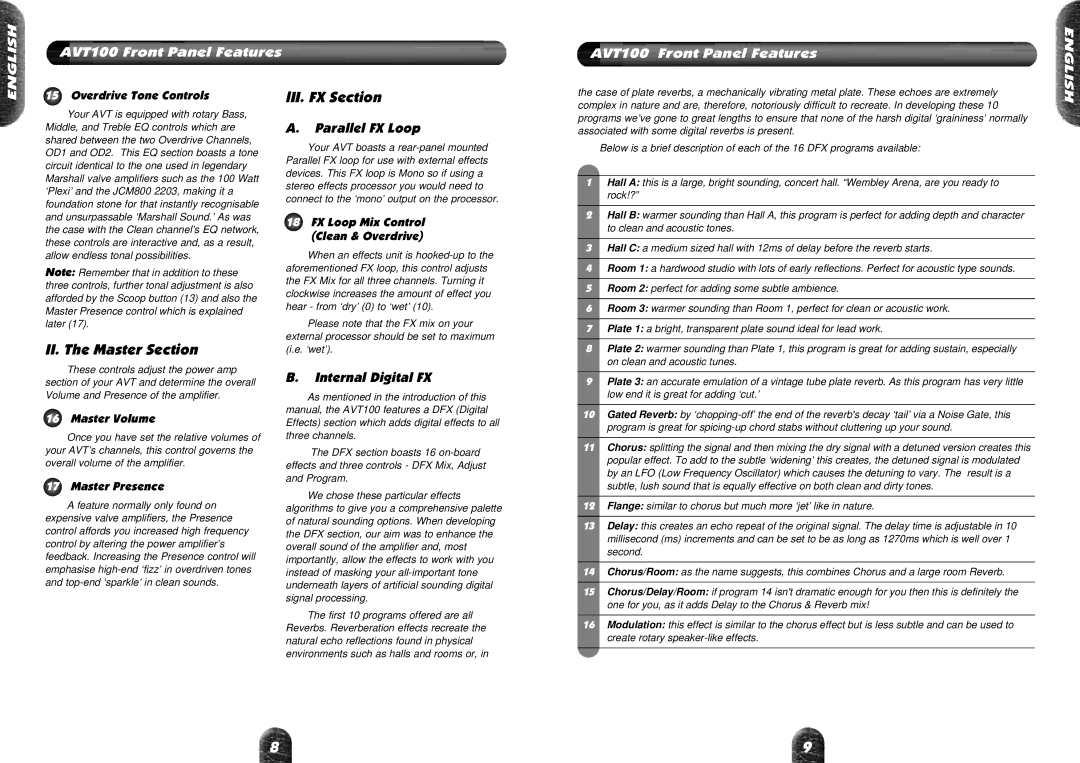
ENGLISH
AVT100 Front Panel Features
AVT100 Front Panel Features
ENGLISH
15Overdrive Tone Controls
Your AVT is equipped with rotary Bass, Middle, and Treble EQ controls which are shared between the two Overdrive Channels, OD1 and OD2. This EQ section boasts a tone circuit identical to the one used in legendary Marshall valve amplifiers such as the 100 Watt ‘Plexi’ and the JCM800 2203, making it a foundation stone for that instantly recognisable and unsurpassable ‘Marshall Sound.’ As was the case with the Clean channel’s EQ network, these controls are interactive and, as a result, allow endless tonal possibilities.
Note: Remember that in addition to these three controls, further tonal adjustment is also afforded by the Scoop button (13) and also the Master Presence control which is explained later (17).
II. The Master Section
These controls adjust the power amp section of your AVT and determine the overall Volume and Presence of the amplifier.
16Master Volume
Once you have set the relative volumes of your AVT’s channels, this control governs the overall volume of the amplifier.
17Master Presence
A feature normally only found on expensive valve amplifiers, the Presence control affords you increased high frequency control by altering the power amplifier’s feedback. Increasing the Presence control will emphasise
lII. FX Section
A.Parallel FX Loop
Your AVT boasts a
18FX Loop Mix Control (Clean & Overdrive)
When an effects unit is
Please note that the FX mix on your
external processor should be set to maximum (i.e. ‘wet’).
B.Internal Digital FX
As mentioned in the introduction of this manual, the AVT100 features a DFX (Digital Effects) section which adds digital effects to all three channels.
The DFX section boasts 16
We chose these particular effects algorithms to give you a comprehensive palette of natural sounding options. When developing the DFX section, our aim was to enhance the overall sound of the amplifier and, most importantly, allow the effects to work with you instead of masking your
The first 10 programs offered are all Reverbs. Reverberation effects recreate the natural echo reflections found in physical environments such as halls and rooms or, in
the case of plate reverbs, a mechanically vibrating metal plate. These echoes are extremely complex in nature and are, therefore, notoriously difficult to recreate. In developing these 10 programs we’ve gone to great lengths to ensure that none of the harsh digital ‘graininess’ normally associated with some digital reverbs is present.
Below is a brief description of each of the 16 DFX programs available:
1Hall A: this is a large, bright sounding, concert hall. “Wembley Arena, are you ready to rock!?”
2Hall B: warmer sounding than Hall A, this program is perfect for adding depth and character to clean and acoustic tones.
3Hall C: a medium sized hall with 12ms of delay before the reverb starts.
4Room 1: a hardwood studio with lots of early reflections. Perfect for acoustic type sounds.
5Room 2: perfect for adding some subtle ambience.
6Room 3: warmer sounding than Room 1, perfect for clean or acoustic work.
7Plate 1: a bright, transparent plate sound ideal for lead work.
8Plate 2: warmer sounding than Plate 1, this program is great for adding sustain, especially on clean and acoustic tunes.
9Plate 3: an accurate emulation of a vintage tube plate reverb. As this program has very little low end it is great for adding ‘cut.’
10Gated Reverb: by
11Chorus: splitting the signal and then mixing the dry signal with a detuned version creates this popular effect. To add to the subtle ‘widening’ this creates, the detuned signal is modulated by an LFO (Low Frequency Oscillator) which causes the detuning to vary. The result is a subtle, lush sound that is equally effective on both clean and dirty tones.
12Flange: similar to chorus but much more ‘jet’ like in nature.
13Delay: this creates an echo repeat of the original signal. The delay time is adjustable in 10 millisecond (ms) increments and can be set to be as long as 1270ms which is well over 1 second.
14Chorus/Room: as the name suggests, this combines Chorus and a large room Reverb.
15Chorus/Delay/Room: if program 14 isn't dramatic enough for you then this is definitely the one for you, as it adds Delay to the Chorus & Reverb mix!
16Modulation: this effect is similar to the chorus effect but is less subtle and can be used to create rotary
8 | 9 |
